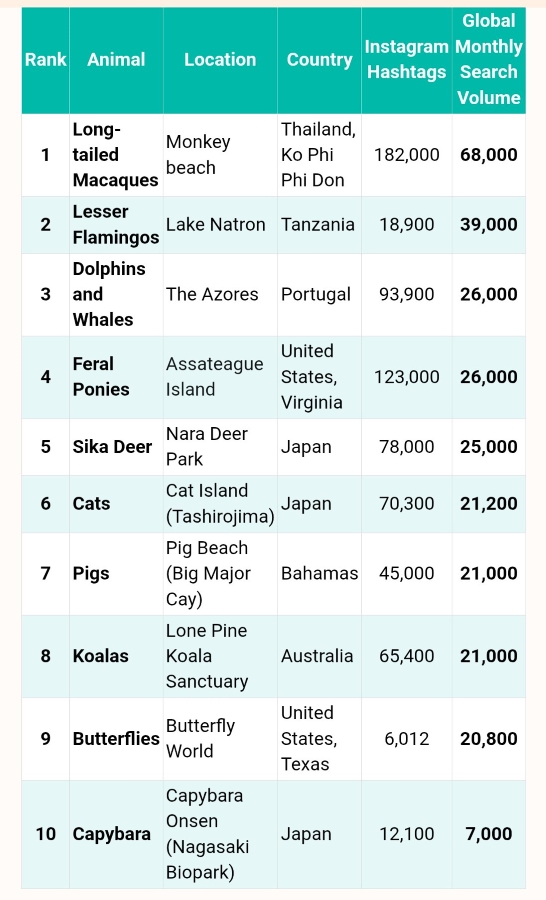Nearly 40,000 people search for Tanzanian flamingoes precisely those found at Lake Natron, in the Northern Region of Arusha.
Wildlife tourism is experiencing explosive growth, with the industry expanding at 5.2 percent annually as travelers increasingly seek out nature and animal experiences, reflected in the growing “biophilia” travel trend.
“Our innate human desire to connect with nature and wildlife!”
But out of the entire world’s wonders which majestic animal experiences are capturing most attention?
Towards the World Nature Conservation Day, observed on the 28th of July, the experts at Japan Railway (JR) Pass analyzed search volumes and social media engagement to identify the world’s most sought-after animal encounters in 2025.
Leading with 68,000 monthly searches, Ko Phi Phi Don’s uninhabited Monkey Beach offers encounters with playful long-tailed macaques in their pristine natural habitat.
Famous as the filming location for Leonardo DiCaprio’s “The Beach,” this island paradise requires day tours only, no overnight stays allowed.
The macaques roam freely along white sand beaches, creating an Instagram-worthy backdrop that’s generated 182,000 hashtags and counting.
Tanzania’s Million Flamingos Take Second Place
Tanzania’s Lesser Flamingos at Lake Natron claims second place with 39,000 monthly searches.
According to researchers this is for good reason.
Over one million Lesser Flamingos migrate here annually, transforming caustic waters into a living sea of pink feathers.
This alkaline lake, located at the foot of the active Lengai Volcano is as toxic as household bleach, but hosts 75 percent of the world’s Lesser Flamingo population in conditions that would kill most creatures.
Featured on David Attenborough’s Planet Earth in 2019, this otherworldly spectacle peaks during the breeding season from August to November.
Portugal’s Cetacean Watching Ranks Third
The Azores archipelago attracts 26,000 monthly searches for exceptional dolphin and whale encounters.
This Portuguese destination hosts over 28 species in Atlantic waters, from playful dolphins to massive sperm whales and even blue whales.
Peak viewing from May to September offers near-guaranteed sightings against stunning volcanic island backdrops, with sustainable tourism practices that have earned international recognition for conservation efforts.
America’s Swimming Ponies Draw Massive Interest
Assateague Island’s ponies are the third most sought out majestic animal encounter, seeing over 26,000 searches each month, and have also built up an impressive 123,000 Instagram hashtags.
The famous wild horses inhabiting the island are actually feral ponies, small in stature due to their diet of beach grass and harsh coastal conditions. About 300 animals live in two herds at opposite ends of the island.
This year marks the 100th anniversary for the “annual pony swim” on July 30th, where the herd swims to nearby Chincoteague Island, where young horses are auctioned to control population numbers.
Japan’s Bowing Deer Complete Top Five
Nara Park’s Sika Deer rank fifth, attracting over 25,000 monthly searches.
Around 1,200 sacred Sika deer roam freely through this historic park, revered as divine messengers and protected as a natural treasure.
These semi-tame animals have learned to bow politely to tourists in exchange for special deer crackers, creating one of the world’s most charming and uniquely Japanese wildlife interactions.
The top ten listing follows here


